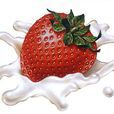strawberry,英語辭彙,基本釋義為草莓。
基本介紹
- 中文學名:草莓
- 別稱:strawberry
- 界:植物界
- 科:薔薇科
- 屬:草莓屬

strawberry,英語辭彙,基本釋義為草莓。
《Strawberry Stain》是張曼玉的音樂作品,收錄於專輯《Clean電影原聲帶》中。...... 《Strawberry Stain》是張曼玉的音樂作品,收錄於專輯《Clean電影原聲帶》中。...
Strawberry Milk(딸기우유),中文譯名“草莓牛奶”,是韓國女子偶像組合Crayon Pop的子團,由雙胞胎成員許敏真(ChoA)、許敏善(Way)組成。2014年10月15日,以...
《Strawberry Nauts》遊戲,一直只描繪學園純愛劇的HOOKSOFT這次的主題是,“戀愛的幼苗”。想要永遠在一起,這種想法有著怎樣的契機呢——是一見鐘情,也或許是戀心...
“Strawberry Fields Forever”(參考譯名:永遠的草莓地)是一首英國搖滾樂隊披頭士樂隊的歌曲。這首歌由約翰·列儂所作,署名為列儂-麥卡特尼創作組合。它的靈感來源於...
Strawberry kisses是澳大利亞童星Nikki Webster的歌曲。該歌曲作為推廣Nikki Webster首張錄音室專輯Follow Your Heart。的首支單曲於2001年6月11日在澳大利亞發行並派台...
《Strawberry Feels》是一款學園戀愛ADV遊戲。遊戲的劇情設定在遠離陸地的海面上的一個小島,名為遙海島(はるみじま)。島上只有一座學校——涼東學園(りょうとう...
圖集 Strawberry Shortcake圖冊 V百科往期回顧 詞條統計 瀏覽次數:次 編輯次數:2次歷史版本 最近更新: 創建者:血刃烏鴉m51猜你關注...
Strawberry Swing是著名樂隊Coldplay(酷玩樂隊)演唱的一首歌,收錄在其2008年發行的專輯《Viva la Vida》中,2008年該專輯銷量達到全球第一。...
strawberry,英語辭彙,基本釋義為草莓。...... strawberry,英語辭彙,基本釋義為草莓。中文學名 草莓 別稱 strawberry 界 植物界 科 薔薇科 屬 草莓屬 ...
《Strawberry letter 23》是歌手Yuna發行專輯《最新熱歌慢搖76》中的一首歌曲。...... 《Strawberry letter 23》是歌手Yuna發行專輯《最新熱歌慢搖76》中的一首歌曲...
strawberrylove是一款壁紙美化類軟體,運行環境支持Android 1.5。...... 圖集 strawberrylove圖冊 V百科往期回顧 詞條統計 瀏覽次數:次 編輯次數:3次歷史版本 最近更...
strawberry(SAUL 專輯)編輯 鎖定 SAUL2012年發行的後搖專輯。中文名稱 草莓 外文名稱 Strawberry 專輯歌手 saul 曲目數量 7 發行時間 2012-06-08 音樂風格 ...
《Strawberry Sex》是平井堅的音樂作品,收錄在《THE STILL LIFE Deluxe Edition》專輯中。...
《Strawberry Fields》是米倉千尋的音樂作品,收錄在《Always》專輯中。...... 《Strawberry Fields》是米倉千尋的音樂作品,收錄在《Always》專輯中。外文名稱 Strawbe...
Strawberry Trapper 是《LoveLive!Sunshine!!》3人小隊Guilty Kiss!的首張小隊單曲《Strawberry Trapper》中的同名主題曲。...
《Strawberry Letter》是歌手Akon專輯《Stadium-Konvict Muzik-Universal Motown》的一首歌曲。...
《STRAWBERRY サディスティック》是E-Girls演唱的歌曲。收錄於《熱血街區》系列電視劇、電影的原聲專輯《HiGH & LOW ORIGINAL BEST ALBUM》,是劇中“莓美瑠狂...
《Strawberry Jam》是大冢愛的音樂作品,收錄在《Love Jam》專輯中。...... 《Strawberry Jam》是大冢愛的音樂作品,收錄在《Love Jam》專輯中。所屬專輯 Love Jam...
士多啤梨,即草莓,港譯士多啤梨是其英語名稱Strawberry的音譯,又名鳳梨草莓、紅莓、洋莓、地莓、地桃。草莓外觀呈心形,其色鮮艷粉紅,果肉多汁,酸甜適口,芳香宜人...
Strawberry KissesStrawberry kisses是Nikki的第一支單曲,於2001年6月11日發行,發行後在澳洲和歐洲暢銷,獲得白金銷量。Strawberry Kisses在2001年登上澳洲單曲榜亞軍,...
02 Swallowed Up in Victory 13 Strawberry Pie 03 The Dark World Where I Dwell 14 Sex, Beer, and Pills 04 A Farm Near the Mountains 15 Bug-Bite ...
2009 The Strawberry Shortcake Movie: Sky's the Limit Strawberry Shortcake (voice) Michael Hack Anna Cummer,Andrea Libman 演員 2009 芭比公主之拇指姑娘 ...
2015年3月25日,小倉唯首張個人專輯《Strawberry JAM》發售[10] 2015年4月1日移籍至Sigma Seven 2015年4月6日,小倉唯首張個人專輯《Strawberry JAM》以14614...
1. 驚爆草莓"Strawberry Panic!"(2006) .電影網[引用日期2013-12-17] 2. 驚爆草莓ストロベリー·パニック (2006) .電影網[引用日期2013-12-17]詞條...
04. Strawberry Swing 09. Death And All His Friends 05. The Hardest Part / Postcards From Far Away Prospekt's March 2008-11-24 英語 專輯封面 ...
2007年,李海娜加入Strawberry Cheesecake。2009年,李海娜拍攝了個人第一部電影《愛在拜城》系列之《單相思》而正式出道。 [8] 2010年,她與李緹娜合作主演了薩拉...
3 大湖草莓農場 (DAHU STRAWBERRY FARM) 水蜜桃丁、A級桑葚果粒、特技荔枝濃縮汁、百香果粒 2011.05.27 4 賓漢香料化學有限公司 添加劑 2011.05.28 5 ...
Strawberry Kiss (作詞作品) 竹達彩奈 Sinfonia! Sinfonia!!! 2012-04-11 專輯來源 [54-59] ;單曲來源 [60] 宇德敬子映像作品 發行日期作品名稱 ...
